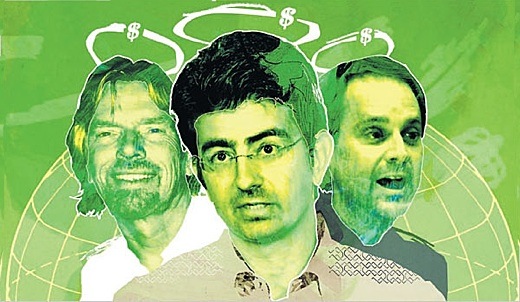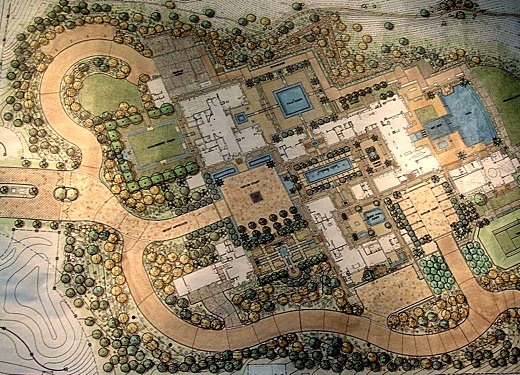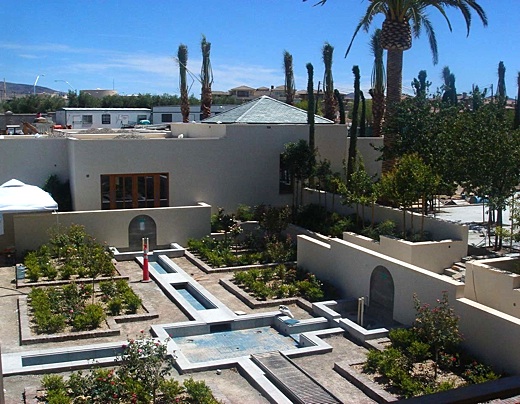SUBHEAD: Consider yourself lucky. The project architect spoke of the 600 units that could be allowed under the zoning, and “entitlements".
By Joan Conrow on 14 November 2012 for Kauai Eclectic -
(http://kauaieclectic.blogspot.com/2012/11/musings-preserving-whats-left.html)

Image above: A new breed of billionaires are out to harness the marketplace as a force for doing good in the underdeveloped world. From left, Sir Richard Branson, Pierre Omidyar and Jeffrey S. Skoll. From (http://www.nytimes.com/2006/11/13/us/13strom.html).
As I drove into Hanalei Valley late yesterday afternoon, past the methodical dismantling of the cliff face, which feels sacrilegious and never ceases to pain me, I heard a guy from the Natural Resources Defense Council say on the radio, “We're turning nature into garbage.”
His comment stuck me with as I walked along the glassy waters of Hanalei Bay, beneath clouds that carried rainbows, shot out silvery beams of light, trying not to look at all the mansions that are now squeezed in along its shore, before I squeezed into the biggest crowd I'd ever seen at the Hanalei School cafeteria.
The official topic was a plan by Ohana Real Estate Investors — whose principal investor is billioniare Pierre Omidyar — to develop an uberluxe 86-room resort in Princeville and 34 house sites along the the Hanalei River ridge.
But the real story was the pervasive sense of grief carried by so many lifetime/longtime residents of the Hanalei-to-Haena community, which has long fought — often unsuccessfully — to keep development, commercialism and tourism from destroying their lifestyle and the area's natural beauty.
For many, the idea of looking up from Hanalei Bay and seeing mansions lining the ridge above the iconic river is just too much to bear.
“It would break the hearts of thousands of people who live here,” said Hayley Ham Young-Giorgio, who spoke of her family's long roots in the region. She said she had talked about the project with her grandmother, Aunty Kalehua HamYoung, who said: “Enough already. Makes me sad. We've already got too much in Hanalei.”
To which Hayley added, to huge applause from the hundreds of people present: “We've got to preserve what's left.”
Among those in attendance were Kepa Kruse, just back from volunteering to help storm victims in New York. He's still hurting from the way Grove Farm evicted his family, and others, from Koloa Camp for a project that has yet to pull permits. And now Hanalei, the other place that figured so prominently in his youth, is under attack, he said.
His sentiments were shared by the many young people who showed up, some with their own keiki in tow, to express their often tearful fears that something special would be irretrievably lost if the project moves forward as planned.

Image above: Architect's rendered plan of Pierre Omidyar’s 48,000 square foot mega-estate in Las Vegas. That's about as big as 50 planatation cottages. Click to enlargeFrom (http://christophechoo.blogspot.com/2010/11/never-before-seen-pictures-of-pierre.html)
Though the development team spent 42 minutes talking about “breathing new life” into the old Hanalei Plantation resort, “hotel structures that touch the earth lightly,” humility, sustainability, cultural sensitivity, educational opportunities, “architecture that blends into nature” and how “it's a passion of ours to do projects that really mean something in the communities,” the crowd wasn't buying it.
“We've been fooled before,” said former Hanalei School Principal Nick Beck, who has worked to protect the ridges around Hanalei from the visual impact of development. He went on to point out that design guidelines intended to make the houses less obtrusive mean nothing because they aren't enforced.
“You cannot hide a quarter-million square feet of development on that slope,” noted Carl Imparto.
Even John Ferry, whose Bali Hai Realty has fostered much of the region's growth, was aghast. “We just can't overbuild anymore,” he said. “We have to put an end to it.”
As lifetime resident Bobo Ham Young began to speak, his voice cracked with tears. “Excuse me, I get all jam up,” he said, before going on to say there's a reason why three developers had been unable to make a go of a resort project on the site. “The place is kolohe. That's all I can say. Have the iwis (bones) over there that kind of shut things down.”
“The night marchers are still there,” said Louise Sausen, who fought to keep Joe Brescia from building a house over iwi at Naue. “They still walk up that road. That area is significant, and not just that area, but the whole of Hanalei.”
She spoke for many when she referenced the dramatic changes to the region, “the pain my kupuna are suffering,” and asked, “What else do we have to give up?”
And why, people wanted to know, did they have to give it up for Omidyar, who is already one of the world's richest men. “What does Pierre think?” one woman asked. “Where's Pierre?” some folks called out.
According to the development reps, Eric Crispin and Michelle Swartman, Pierre focuses on his charitable projects and is not involved in the day-to-day operations of Ohana Realty. Decisions are made by the management team and board of directors, and Pierre serves on neither.
Or in other words, Pierre likes to be publicly affiliated with his philanthropic endeavors, while leaving to others the dirty business of turning his money into more money through unpopular development projects.
As the night wore on, a few people wanted to know why the developer was pursuing the project when so many residents are opposed.
“This is a business,” Crispin said. “We are a development company. That said, we define development differently. We are trying to find a balance between what's financially feasible and what's good for the environment. We know you would rather have nothing, but to us, that's not viable or reasonable.”

Image above: Just another villa. Photo of Piere Omidyar's Mac-Castle under construction in 2010in Las Vegas. From (http://christophechoo.blogspot.com/2010/11/never-before-seen-pictures-of-pierre.html)
And then came the clincher, although the ground had laid been laid earlier in the night, when the project architect spoke of the 600 units that could be allowed under the zoning, and “entitlements” to the 204 units approved back in the 1980s, when Bruce Stark tried to develop a resort there.
“If not us, others would do it,” Crispin said.
.
By Joan Conrow on 14 November 2012 for Kauai Eclectic -
(http://kauaieclectic.blogspot.com/2012/11/musings-preserving-whats-left.html)

Image above: A new breed of billionaires are out to harness the marketplace as a force for doing good in the underdeveloped world. From left, Sir Richard Branson, Pierre Omidyar and Jeffrey S. Skoll. From (http://www.nytimes.com/2006/11/13/us/13strom.html).
As I drove into Hanalei Valley late yesterday afternoon, past the methodical dismantling of the cliff face, which feels sacrilegious and never ceases to pain me, I heard a guy from the Natural Resources Defense Council say on the radio, “We're turning nature into garbage.”
His comment stuck me with as I walked along the glassy waters of Hanalei Bay, beneath clouds that carried rainbows, shot out silvery beams of light, trying not to look at all the mansions that are now squeezed in along its shore, before I squeezed into the biggest crowd I'd ever seen at the Hanalei School cafeteria.
The official topic was a plan by Ohana Real Estate Investors — whose principal investor is billioniare Pierre Omidyar — to develop an uberluxe 86-room resort in Princeville and 34 house sites along the the Hanalei River ridge.
But the real story was the pervasive sense of grief carried by so many lifetime/longtime residents of the Hanalei-to-Haena community, which has long fought — often unsuccessfully — to keep development, commercialism and tourism from destroying their lifestyle and the area's natural beauty.
For many, the idea of looking up from Hanalei Bay and seeing mansions lining the ridge above the iconic river is just too much to bear.
“It would break the hearts of thousands of people who live here,” said Hayley Ham Young-Giorgio, who spoke of her family's long roots in the region. She said she had talked about the project with her grandmother, Aunty Kalehua HamYoung, who said: “Enough already. Makes me sad. We've already got too much in Hanalei.”
To which Hayley added, to huge applause from the hundreds of people present: “We've got to preserve what's left.”
Among those in attendance were Kepa Kruse, just back from volunteering to help storm victims in New York. He's still hurting from the way Grove Farm evicted his family, and others, from Koloa Camp for a project that has yet to pull permits. And now Hanalei, the other place that figured so prominently in his youth, is under attack, he said.
His sentiments were shared by the many young people who showed up, some with their own keiki in tow, to express their often tearful fears that something special would be irretrievably lost if the project moves forward as planned.

Image above: Architect's rendered plan of Pierre Omidyar’s 48,000 square foot mega-estate in Las Vegas. That's about as big as 50 planatation cottages. Click to enlargeFrom (http://christophechoo.blogspot.com/2010/11/never-before-seen-pictures-of-pierre.html)
Though the development team spent 42 minutes talking about “breathing new life” into the old Hanalei Plantation resort, “hotel structures that touch the earth lightly,” humility, sustainability, cultural sensitivity, educational opportunities, “architecture that blends into nature” and how “it's a passion of ours to do projects that really mean something in the communities,” the crowd wasn't buying it.
“We've been fooled before,” said former Hanalei School Principal Nick Beck, who has worked to protect the ridges around Hanalei from the visual impact of development. He went on to point out that design guidelines intended to make the houses less obtrusive mean nothing because they aren't enforced.
“You cannot hide a quarter-million square feet of development on that slope,” noted Carl Imparto.
Even John Ferry, whose Bali Hai Realty has fostered much of the region's growth, was aghast. “We just can't overbuild anymore,” he said. “We have to put an end to it.”
As lifetime resident Bobo Ham Young began to speak, his voice cracked with tears. “Excuse me, I get all jam up,” he said, before going on to say there's a reason why three developers had been unable to make a go of a resort project on the site. “The place is kolohe. That's all I can say. Have the iwis (bones) over there that kind of shut things down.”
“The night marchers are still there,” said Louise Sausen, who fought to keep Joe Brescia from building a house over iwi at Naue. “They still walk up that road. That area is significant, and not just that area, but the whole of Hanalei.”
She spoke for many when she referenced the dramatic changes to the region, “the pain my kupuna are suffering,” and asked, “What else do we have to give up?”
And why, people wanted to know, did they have to give it up for Omidyar, who is already one of the world's richest men. “What does Pierre think?” one woman asked. “Where's Pierre?” some folks called out.
According to the development reps, Eric Crispin and Michelle Swartman, Pierre focuses on his charitable projects and is not involved in the day-to-day operations of Ohana Realty. Decisions are made by the management team and board of directors, and Pierre serves on neither.
Or in other words, Pierre likes to be publicly affiliated with his philanthropic endeavors, while leaving to others the dirty business of turning his money into more money through unpopular development projects.
As the night wore on, a few people wanted to know why the developer was pursuing the project when so many residents are opposed.
“This is a business,” Crispin said. “We are a development company. That said, we define development differently. We are trying to find a balance between what's financially feasible and what's good for the environment. We know you would rather have nothing, but to us, that's not viable or reasonable.”

Image above: Just another villa. Photo of Piere Omidyar's Mac-Castle under construction in 2010in Las Vegas. From (http://christophechoo.blogspot.com/2010/11/never-before-seen-pictures-of-pierre.html)
And then came the clincher, although the ground had laid been laid earlier in the night, when the project architect spoke of the 600 units that could be allowed under the zoning, and “entitlements” to the 204 units approved back in the 1980s, when Bruce Stark tried to develop a resort there.
“If not us, others would do it,” Crispin said.
.
No comments :
Post a Comment